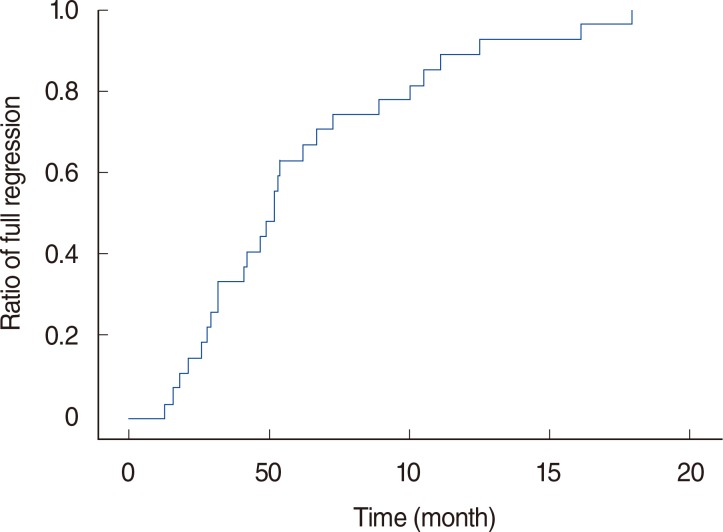Clin Exp Otorhinolaryngol.
2015 Dec;8(4):416-421. 10.3342/ceo.2015.8.4.416.
Tumor Regression Patterns Based on Follow-up Duration in Patients With Head and Neck Squamous Cell Carcinoma Treated With Radiotherapy or Chemoradiotherapy
- Affiliations
-
- 1Department of Radiation Oncology, Kyung Hee University Medical Center, Kyung Hee University School of Medicine, Seoul, Korea. kongmoonkyoo@khu.ac.kr
- KMID: 2128920
- DOI: http://doi.org/10.3342/ceo.2015.8.4.416
Abstract
OBJECTIVES
We describe patterns of tumor regression based on follow-up duration after radiotherapy (RT) or chemo-RT in patients with head and neck squamous cell carcinoma.
METHODS
Thirty-one patients with head and neck squamous cell carcinoma were included in this study and received definitive RT or chemo-RT. The pattern of primary tumor regression after treatment was evaluated every 1 to 2 months. Predictive factors for the length of time to full regression were also analyzed.
RESULTS
Among all patients, 27 patients showed regression of the primary tumor, 24 patients showed >50% regression, and 15 patients showed total regression. The primary tumor gradually regressed during the course of follow-up. The median time to full regression was 5.2 months (range, 1.3 to 17.9 months). In the 24 patients who showed >50% regression, the rate of >50% regression increased over time as follows: 25.0% at 1 month, 62.5% at 2 months, 75.0% at 3 months, 91.7% at 4 months, and 95.8% at 5 months. Higher total RT dose and shorter RT duration were associated with longer time to full regression.
CONCLUSION
A substantial number of patients showed continuous regression of the primary tumor for more than 2 months after treatment. The timing for evaluation of tumor regression must be greater than 2 months from the completion of RT or chemo-RT in patients with head and neck squamous cell carcinoma.
MeSH Terms
Figure
Reference
-
1. Dias FL. Assessment of treatment response after chemoradiation of head and neck cancer. Curr Oncol Rep. 2013; 4. 15(2):119–127. PMID: 23296563.
Article2. Jeong S, Yoo EJ, Kim JY, Han CW, Kim KJ, Kay CS. Re-irradiation of unresectable recurrent head and neck cancer: using Helical Tomotherapy as image-guided intensity-modulated radiotherapy. Radiat Oncol J. 2013; 12. 31(4):206–215. PMID: 24501708.
Article3. Joshi A, Calman F, O'Connell M, Jeannon JP, Pracy P, Simo R. Current trends in the follow-up of head and neck cancer patients in the UK. Clin Oncol (R Coll Radiol). 010; 3. 22(2):114–118. PMID: 20060693.
Article4. de Visscher AV, Manni JJ. Routine long-term follow-up in patients treated with curative intent for squamous cell carcinoma of the larynx, pharynx, and oral cavity. Does it make sense? Arch Otolaryngol Head Neck Surg. 1994; 9. 120(9):934–939. PMID: 8074820.
Article5. Cooney TR, Poulsen MG. Is routine follow-up useful after combined-modality therapy for advanced head and neck cancer? Arch Otolaryngol Head Neck Surg. 1999; 4. 125(4):379–382. PMID: 10208674.
Article6. Kothari P, Trinidade A, Hewitt RJ, Singh A, O'Flynn P. The follow-up of patients with head and neck cancer: an analysis of 1,039 patients. Eur Arch Otorhinolaryngol. 2011; 8. 268(8):1191–1200. PMID: 21193920.
Article7. Saito N, Nadgir RN, Nakahira M, Takahashi M, Uchino A, Kimura F, et al. Posttreatment CT and MR imaging in head and neck cancer: what the radiologist needs to know. Radiographics. 2012; Sep-Oct. 32(5):1261–1282. PMID: 22977017.
Article8. Lell M, Baum U, Greess H, Nomayr A, Nkenke E, Koester M, et al. Head and neck tumors: imaging recurrent tumor and post-therapeutic changes with CT and MRI. Eur J Radiol. 2000; 3. 33(3):239–247. PMID: 10699740.
Article9. Offiah C, Hall E. Post-treatment imaging appearances in head and neck cancer patients. Clin Radiol. 2011; 1. 66(1):13–24. PMID: 21147294.
Article10. Mukherji SK, Wolf GT. Evaluation of head and neck squamous cell carcinoma after treatment. AJNR Am J Neuroradiol. 2003; 10. 24(9):1743–1746. PMID: 14561596.11. Ojiri H, Mendenhall WM, Mancuso AA. CT findings at the primary site of oropharyngeal squamous cell carcinoma within 6-8 weeks after definitive radiotherapy as predictors of primary site control. Int J Radiat Oncol Biol Phys. 2002; 3. 52(3):748–754. PMID: 11849798.
Article12. Hermans R, Pameijer FA, Mancuso AA, Parsons JT, Mendenhall WM. Laryngeal or hypopharyngeal squamous cell carcinoma: can follow-up CT after definitive radiation therapy be used to detect local failure earlier than clinical examination alone? Radiology. 2000; 3. 214(3):683–687. PMID: 10715030.
Article13. Passero VA, Branstetter BF, Shuai Y, Heron DE, Gibson MK, Lai SY, et al. Response assessment by combined PET-CT scan versus CT scan alone using RECIST in patients with locally advanced head and neck cancer treated with chemoradiotherapy. Ann Oncol. 2010; 11. 21(11):2278–2283. PMID: 20430907.
Article14. Sjovall J, Brun E, Almquist H, Kjellen E, Wahlberg P. Radiotherapy response in head and neck cancer - evaluation of the primary tumour site. Acta Otolaryngol. 2014; 6. 134(6):646–651. PMID: 24707930.15. Yom SS, Machtay M, Biel MA, Sinard RJ, El-Naggar AK, Weber RS, et al. Survival impact of planned restaging and early surgical salvage following definitive chemoradiation for locally advanced squamous cell carcinomas of the oropharynx and hypopharynx. Am J Clin Oncol. 2005; 8. 28(4):385–392. PMID: 16062081.
Article
- Full Text Links
- Actions
-
Cited
- CITED
-
- Close
- Share
- Similar articles
-
- Chemotherapy of Head and Neck Cancer
- Expression of Cyclin D1 Protein and Ki-67 Index in Advanced Squamous Cell Carcinomas of Head and Neck and Correlation with Response to Chemotherapy and Radiotherapy
- A Case of Sarcomatoid Carcinoma of Larynx
- A Case of Metachronous Carcinosarcoma and Squamous Cell Carcinoma of the Both Parotid Glands
- A Case of Basaloid Squamous Cell Carcinoma in the Nasal Cavity




